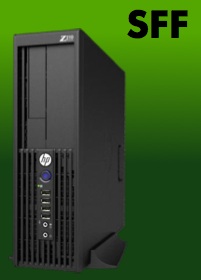Yes, you really do need a workstation

OK, you might not specifically. And a whole lot of your users probably don't either. In fact, we should probably take a step back and define what a workstation is beyond just a really big desktop computer. Once we do that, though, HP's new line of small form factor workstations makes one heck of a case for deploying workstations in selected areas, both in secondary and post-secondary education.

Similarly, it's the rare PC offering that lets folks upgrade to Xeon processors and the motherboards required to support them. Traditionally, workstations have been the tools of choice for high-end graphics work, video editing, etc., and they generally support expensive, high-powered discrete 2D or 3D graphics options, depending upon a customer's application.
Finally, the hardware itself is generally designed for longer life running at high capacity than most consumer offerings. I still have a couple of 10-year old Dell workstations running web servers that stay on all the time without a hiccup.
So I've had the chance to live with one of HPs new Z210 series workstations for the last month and, aside from my new MacBook Air (another story for another day), it's become my primary machine. I am, in fact, loathe to see it get on the UPS truck on Monday. There are faster options available and there are fancier models that lend themselves to creating Avatar-style content. However, the Z210 sitting on my desk is mighty fast and the easiest small computer I've ever broken open and serviced (shhhh...don't tell the folks at HP).
I've used this machine with Adobe's latest Creative Suite (5.5), putting it through its paces particularly with Premier and Photoshop. For around $1400, I couldn't be happier with the performance of the Xeon E31225 or the integrated Intel HD P3000 graphics. That's right, integrated graphics handling 3D smoothly in Photoshop and the lowest end Xeon available in this machine.
The beauty of this setup is that it's essentially silent, runs very cool, uses relatively small amounts of power, and is accessible at a price that could actually work in a graphics or engineering lab on public school budgets. While HP's largest customers to date have been universities using them in math, science, and engineering labs, tech schools and comprehensive high schools are also getting on board.
High-performance systems could be had for less, but even my old white MacBook makes more noise when it has too many browser windows running Flash and it certainly couldn't render HD video like this one can. Most likely they also wouldn't include a couple of 6GBps SATA channels or a 90% efficient chassis either.
I might sound like an HP marketing brochure here, but I'm actually going to be buying one of these machines myself to replace the one I have to send back. I'm just spending too much time in Creative Suite and doing too much video editing to spend time waiting. HP has promised to send me another test workstation as soon as this one heads back with a higher end Xeon processor and a discrete 3D graphics card for me to get a sense of where that sweet spot of performance vs. price lies. It's pretty close in this machine, but there are probably higher education settings where a faster processor would make sense.
Even for me, while the Premier performance was very good (better than my second-gen Core i7 mobile quad laptop with a 1GB graphics card), the processor-intensive rendering step would definitely benefit from a larger cache and higher clock speed. The low-power Xeon I'm running doesn't have hyperthreading enabled either, leaving Premier with only 4 cores instead of the 8 available on the replacement HP will be sending (and available on several of their optional processors). However, even some pretty serious calculation loops in Maple couldn't make this thing sweat. And it's no bigger than an average desktop PC.
Yes, I'm enthusiastic about HPs new workstations. There are a lot of places in secondary and higher education that could benefit from workstation-class performance but haven't been able to afford the hardware or energy costs or find the space for what is usually a bulky computer. That's changing here and I'm looking forward to other OEMs following their lead. A bit of competition in this space should make workstations even more accessible where users might have settled for desktop-class performance and reliability.